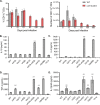Cryptococcus neoformans Evades Pulmonary Immunity by Modulating Xylose Precursor Transport
- PMID: 32423915
- PMCID: PMC7375766
- DOI: 10.1128/IAI.00288-20
Cryptococcus neoformans Evades Pulmonary Immunity by Modulating Xylose Precursor Transport
Abstract
Cryptococcus neoformans is a fungal pathogen that kills almost 200,000 people each year and is distinguished by abundant and unique surface glycan structures that are rich in xylose. A mutant strain of C. neoformans that cannot transport xylose precursors into the secretory compartment is severely attenuated in virulence in mice yet surprisingly is not cleared. We found that this strain failed to induce the nonprotective T helper cell type 2 (Th2) responses characteristic of wild-type infection, instead promoting sustained interleukin 12p40 (IL-12p40) induction and increased IL-17A (IL-17) production. It also stimulated dendritic cells to release high levels of proinflammatory cytokines, a behavior we linked to xylose expression. We further discovered that inducible bronchus-associated lymphoid tissue (iBALT) forms in response to infection with either wild-type cryptococci or the mutant strain with reduced surface xylose; although iBALT formation is slowed in the latter case, the tissue is better organized. Finally, our temporal studies suggest that lymphoid structures in the lung restrict the spread of mutant fungi for at least 18 weeks after infection, which is in contrast to ineffective control of the pathogen after infection with wild-type cells. These studies demonstrate the role of xylose in modulation of host response to a fungal pathogen and show that cryptococcal infection triggers iBALT formation.
Keywords: Cryptococcus neoformans; encapsulated pathogens; fungal pathogenesis; iBALT; inducible bronchus-associated lymphoid tissue; pathogenic fungus; pulmonary immunity; xylose.
Copyright © 2020 American Society for Microbiology.
Figures





Similar articles
-
Dectin-2 deficiency promotes Th2 response and mucin production in the lungs after pulmonary infection with Cryptococcus neoformans.Infect Immun. 2015 Feb;83(2):671-81. doi: 10.1128/IAI.02835-14. Epub 2014 Nov 24. Infect Immun. 2015. PMID: 25422263 Free PMC article.
-
Role of IL-17A on resolution of pulmonary C. neoformans infection.PLoS One. 2011 Feb 17;6(2):e17204. doi: 10.1371/journal.pone.0017204. PLoS One. 2011. PMID: 21359196 Free PMC article.
-
Interleukin-17A enhances host defense against cryptococcal lung infection through effects mediated by leukocyte recruitment, activation, and gamma interferon production.Infect Immun. 2014 Mar;82(3):937-48. doi: 10.1128/IAI.01477-13. Epub 2013 Dec 9. Infect Immun. 2014. PMID: 24324191 Free PMC article.
-
Role of dendritic cell-pathogen interactions in the immune response to pulmonary cryptococcal infection.Future Microbiol. 2015;10(11):1837-57. doi: 10.2217/fmb.15.92. Future Microbiol. 2015. PMID: 26597428 Free PMC article. Review.
-
Detrimental impact of the IL-33/ST2 axis in an animal infection model with Cryptococcus neoformans.Allergol Int. 2023 Oct;72(4):530-536. doi: 10.1016/j.alit.2023.07.002. Epub 2023 Jul 21. Allergol Int. 2023. PMID: 37482531 Review.
Cited by
-
Human Airway Epithelium Responses to Invasive Fungal Infections: A Critical Partner in Innate Immunity.J Fungi (Basel). 2022 Dec 27;9(1):40. doi: 10.3390/jof9010040. J Fungi (Basel). 2022. PMID: 36675861 Free PMC article. Review.
-
Genomic Variation across a Clinical Cryptococcus Population Linked to Disease Outcome.mBio. 2022 Dec 20;13(6):e0262622. doi: 10.1128/mbio.02626-22. Epub 2022 Nov 10. mBio. 2022. PMID: 36354332 Free PMC article.
-
Two nucleotide sugar transporters are important for cell wall integrity and full virulence of Magnaporthe oryzae.Mol Plant Pathol. 2023 Apr;24(4):374-390. doi: 10.1111/mpp.13304. Epub 2023 Feb 12. Mol Plant Pathol. 2023. PMID: 36775579 Free PMC article.
-
Immunometabolic chaos in septic shock.J Leukoc Biol. 2025 Feb 13;117(2):qiae211. doi: 10.1093/jleuko/qiae211. J Leukoc Biol. 2025. PMID: 39340428 Free PMC article.
-
Reactive Oxygen Species Drive the Aberrant Immune Response to a C. neoformans Chitin Synthase 3 (chs3Δ) Mutant.bioRxiv [Preprint]. 2025 Jun 27:2025.06.24.661434. doi: 10.1101/2025.06.24.661434. bioRxiv. 2025. PMID: 40666971 Free PMC article. Preprint.
References
-
- Wozniak KL, Levitz SM. 2011. T cell and dendritic cell immune responses to Cryptococcus, p 387–396. In Heitman J, Kozel TR, Kwon-Chung KJ, Perfect JR, Casadeval A (ed), Cryptococcus. ASM Press, Washington, DC.
-
- Zhang Y, Wang F, Tompkins KC, McNamara A, Jain AV, Moore BB, Toews GB, Huffnagle GB, Olszewski MA. 2009. Robust Th1 and Th17 immunity supports pulmonary clearance but cannot prevent systemic dissemination of highly virulent Cryptococcus neoformans H99. Am J Pathol 175:2489–2500. doi:10.2353/ajpath.2009.090530. - DOI - PMC - PubMed
Publication types
MeSH terms
Substances
Grants and funding
LinkOut - more resources
Full Text Sources

